Independent Press Journal (IPJ) has conducted an independent study based on U.S. Census data (2010) for the City of Spanish Fort, Alabama, as well as 10-years of Spanish Forth Police Department juvenile arrest data (from 2007-2017).

The goal of this study is to determine the likelihood of a white child being arrested by Spanish Fort Police Department, and the likelihood of a black child being arrested by Spanish Fort Police Department, as well as to study the disparity (if any) that exists in those arrest rates.
The Study
The United States Census Bureau (2010) reports that the city of Spanish Fort, Alabama has a total population of 6,798 people. Of those residents, 91.0% (6,193) are white residents, and 4.8% (324) black residents.

The US Census Bureau (2010) indicates that approximately 1,562 (22.98%) of Spanish Fort’s residents are under18-years-old.
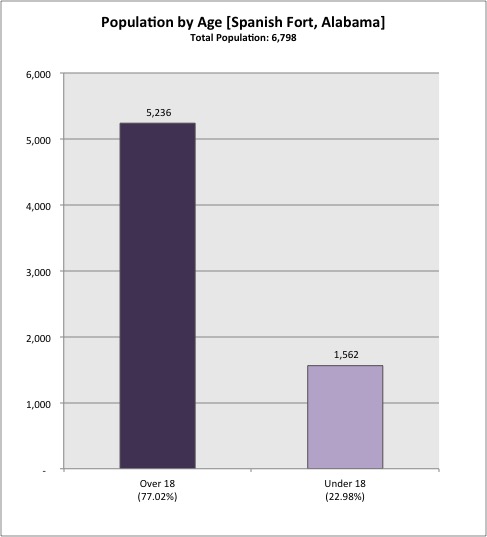
Of Spanish Fort’s 1,562 residents that are under 18-years-old, 91% (1421) are white, 4.8% (75) are Black, 1.4% (22) are Asian, 0.6% (9) are Native American, 0.2% (3) are Pacific Islander, 0.7% (11) are some other race, and 1.4% (22) are mixed.
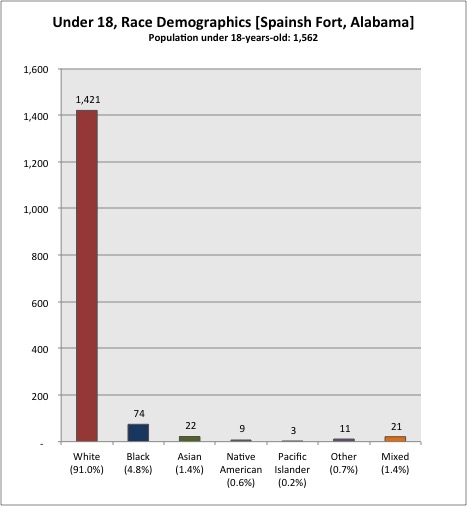
Spanish Fort Police Department (Spanish Fort, Alabama) records reveal that there have been 761 juvenile arrests in the approximately 10-year period from 2007 through 2017.
Of the 761 minors arrested, 71.62% (545) were white, 26.81% (204) were black, and 1.58% (12) were of some other race.
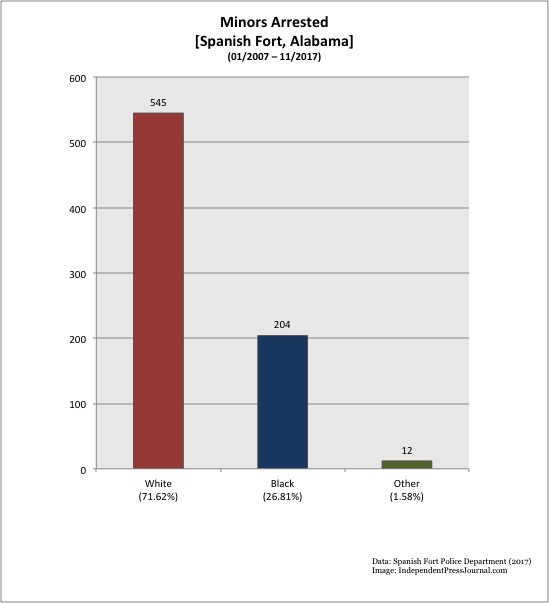
According to US Census data (2010), 91.0% of the child population in Spanish Fort is white, however, only 71.72% of all child arrests are of white children. The white child arrest percentage is less than the white child population percentage.
71.72% < 91.0%
On the other hand, 4.8% of the child population in Spanish Fort is black, and 26.81% of all child arrests are of black children. The black child arrest percentage is greater than the black child population percentage.
26.81% > 4.8%
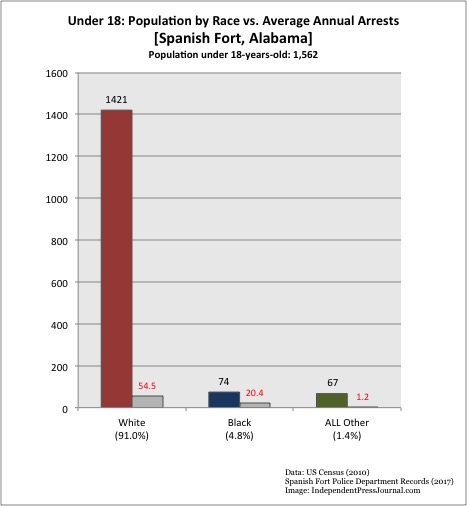
545 white children arrested in a 10-year period indicates an average 54.5 white children arrested per year. Within a population of 1,421, the rate at which white children are arrested is: 3.84%.
In other words, approximately 3.84% of Spanish Fort’s white children are arrested every year.
Approximately 3.84% of Spanish Fort’s white children are arrested every year.
204 black child arrests in a 10-year period indicates an average 20.4 black children arrested per year. Within a population of 74, the rate at which black children are arrested is: 27.4%.
In other words, approximately 27.4% of Spanish Fort’s black children are arrested every year.
Approximately 27.4% of Spanish Fort’s black children are arrested every year.
Comparing the percentage of black children being arrested within their own group, and the percentage of white children being arrested within their own group, a disparity emerges.
The ratio of these two figures indicates the disparity.
3.83% (white) : 27.4% (black)
The ratio above indicates that black children are approximately seven times more likely than white children to be arrested by the Spanish Fort Police Department.

Sample sizes for white and black children are large enough to be conclusive. Sample sizes for race groups other than white and black within the city of Spanish Fort are small, and therefore statistically inconclusive.
The study includes over 10-years of data. Averages were done on a 10-year basis for all datasets equally. Statistics were rounded to the nearest decimal for ease of presentation.
IPJ conducted this research as a blind study. Variables were assigned to all datasets prior to conducting any mathematical calculations to ensure objectivity by research teams. Based on the source data, and IPJ’s research methodology, three (3) separate teams of researchers independently calculated the exact same statistics.
IPJ concludes that a disparity exists within Spanish Fort Police Department’s white/black child arrest rates.
A black child is over 7 times more likely than a white child to be arrested by Spanish Fort Police Department.
Why did IPJ do this research?
 Studies on white/black arrest rate disparity have already been conducted across most major cities in the US. But for some communities–Like Spanish Fort, Alabama–those statistics are not as widely reported, or in some cases, not reported at all.
Studies on white/black arrest rate disparity have already been conducted across most major cities in the US. But for some communities–Like Spanish Fort, Alabama–those statistics are not as widely reported, or in some cases, not reported at all.
According to a USA Today study conducted in 2014, “blacks are more likely than others to be arrested in almost every city for almost every type of crime.”
However, the report “did not include thousands of smaller departments or agencies that serve areas with only a small black population. It also did not include police agencies in most parts of Alabama, Florida and Illinois because those states had not reported complete arrest data to the FBI.”

Due to the lack of reporting in rural areas–and in some states like Alabama–determining the arrest rates by race in those communities requires individualized research.
The arrest of a 15-year-old black student in Daphne, (Alabama) sparked initial interest in arrest rates out of police departments in Baldwin County.

Since that initial story, IPJ has conducted child arrest rate research for Daphne, Alabama – a neighboring city to Spanish Fort – and has found that Daphne Alabama arrests black children at a rate 3 times more than white kids.
Black students and parents in Spanish Fort allege race-based discrimination by law enforcement, teachers, students, and even the Baldwin County school board.
The allegations made by the black community were contributing factors that initiated IPJ’s interest in researching the child arrest rate (by race) within the Spanish Fort Police Department.
The lack of statistical reporting on the topic of child arrests by race as it relates to the City of Spanish Fort, Baldwin County, and Alabama in general compelled IPJ to conduct this independent study.
Report Findings
The arrest rate disparity between white children and black children in the city of Spanish Fort, Alabama is documented and presented in this study.
A black child is over 7 times more likely than a white child to get arrested by the Spanish Fort Police Department.
Since you’re here . . .
Independent Press Journal (IPJ) is a 100% volunteer project that relies on the support of our readers to keep going. In today’s world of special interests and big-money influence, it’s getting harder and harder to find truly independent reporting. That’s why it is more important than ever to support independent journalists who will report the stories that major news outlets won’t.
If everyone who reads and appreciates our reporting becomes an IPJ supporter, our team could dive even deeper into investigations, and report on even more stories that matter.
If you enjoy reading our exclusive, investigative stories, then we invite you to become an IPJ supporter!
For as little as $1, you can become an IPJ supporter – and it only takes a minute.
Please show your support! Thank you.
– Team IPJ









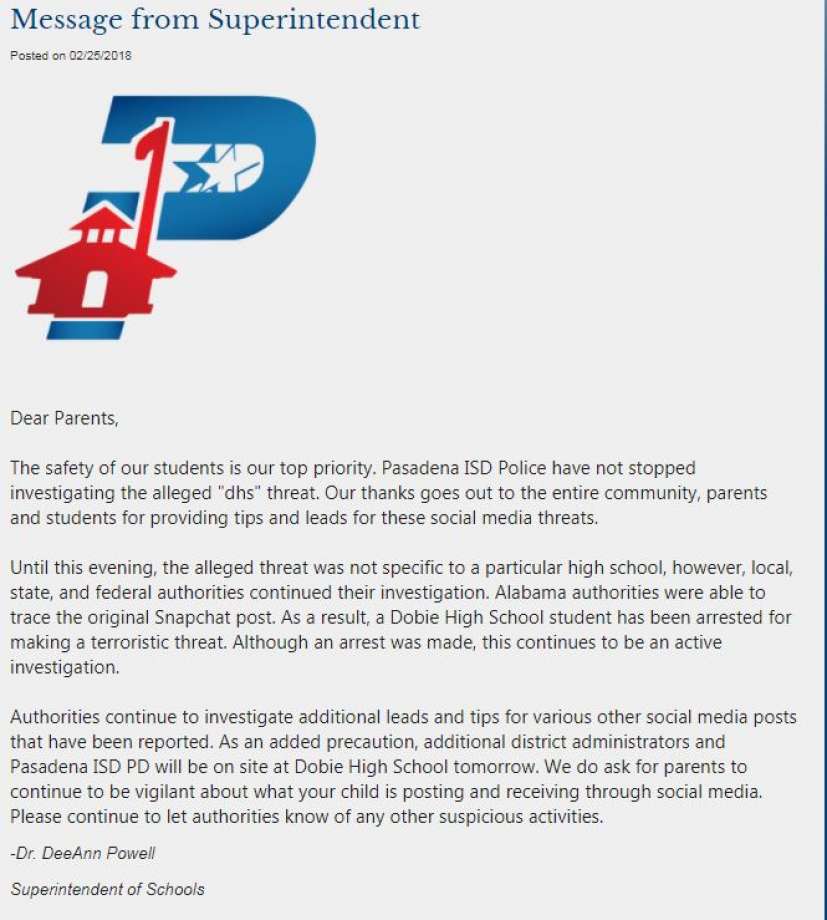
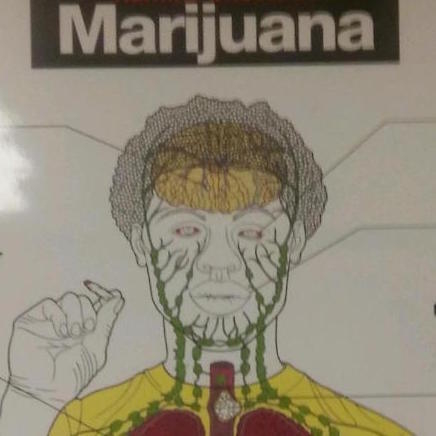





![EXPOSED: The Anti-Government, Government teacher [PowerPoint Slides]](https://independentpressjournal.com/wp-content/uploads/2017/07/gov-t-1-46-jpg-e1501394930153.jpg)
![RACISM EXPOSED: “Where are my white-male federal privileges?” asks Alabama teacher [PowerPoint Slides]](https://independentpressjournal.com/wp-content/uploads/2017/07/gov-t-1-53-jpg-e1501395052799.jpg)
![Multiple students in Alabama post racist songs online [Offensive Content]](https://independentpressjournal.com/wp-content/uploads/2017/11/Screen-Shot-2017-11-02-at-6.49.07-PM-1.png)
People need to admit that something isn’t right. There are hardly any black folks down that way, and what few there are, are being arrested left and right. By the time kids get out of high school, they already got a rap sheet because some white school system threw them into the system early, now it’s 10x harder to break free of the cycle. They supposed to be educating kids, but they’re pushin em into jails is all they doin.
it is what it is… aint nothin gonna change
lets see what happens now that the information is out, probably nothing…